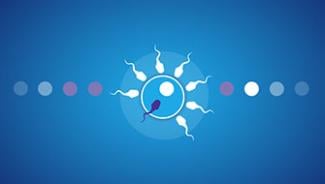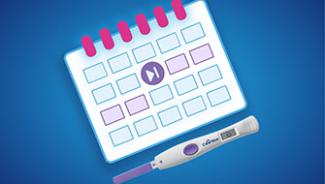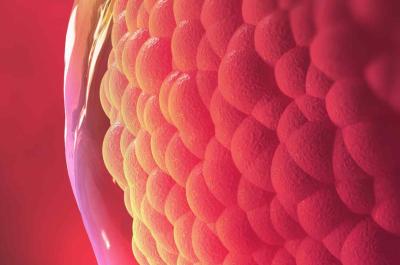How to track ovulation: Choosing the right option for you

There are only a few days (typically six) in every cycle when you can get pregnant; these include the days leading up to and the day of ovulation.1 Tracking when you ovulate can be helpful for understanding your health and fertility. Here we share information on the different methods so you can decide which one is best for you.
How to track ovulation using different methods
There are a lot of different ways to track ovulation, including ovulation predictor kits, calendar methods or observing your body’s changes. Let’s look at all these options so you can choose which method — or even which combination of methods — works for you.
Ovulation tests and fertility monitoring products
Ovulation tests — also commonly referred to as ovulation predictor kits (OPKs) — identify the rise in luteinizing hormone (LH) that occurs about 24-36 hours before your body releases an egg. The rise in LH coincides with your peak fertility days. Some ovulation tests also detect estrogen levels, which rise before an LH surge and indicate you’re entering a high-fertility window. This window typically lasts four or more days.
Since sperm can survive for up to five days, using an ovulation test to identify your peak fertility days and high-fertility window can help you plan the best time to have sex. That’s why these tests are ideal if you are trying to conceive.
Clearblue® offers a range of ovulation tests and fertility monitoring products that detect the rise in LH, or both LH and estrogen, to help you better understand your body’s ovulation cycle and identify your fertile days to maximize your chances of getting pregnant. For example, the Clearblue® Digital Ovulation Test and Clearblue® Advanced Digital Ovulation Test are over 99% accurate at detecting the LH surge.2 The Clearblue® Fertility Monitor with Touch Screen includes test sticks that track the levels of two key fertility hormones (estrogen and LH) to identify the days in each cycle when you are most likely to get pregnant. The touch screen provides your daily fertility status and also tracks and stores your unique fertility information.
Additional fertility-awareness-based methods for tracking ovulation
Fertility awareness is knowing when you can get pregnant during your menstrual cycle. If you don’t want to get pregnant, it’s important not to have sex, or to use a barrier method of birth control, during your fertile window. If you do want to get pregnant, you should have sex every day during your fertile window to maximize your chances.1 Fertility-awareness-based methods include:
Calendar method
The calendar method (also called the rhythm method) relies on the dates of your menstrual cycles to track ovulation.3 Day one of your cycle is the first day of your period, and ovulation usually happens 12 to 16 days before your next period starts.
Because the menstrual cycle typically varies in length between 23 and 35 days, this method may not always be an accurate indication of ovulation, according to the American Academy of Family Physicians.3 You can use our ovulation calculator to see the days you’re most likely to ovulate. It’s common to use the calendar method in combination with another method in case of menstrual cycle irregularities.
Standard Days Method
The Standard Days Method, developed by the Institute for Reproductive Health, Georgetown University, is a slightly modified version of the calendar method. For the standard method to be effective, your cycle must be regular and must be between 26 and 32 days.4 If your menstrual cycle follows these standard rules (hence the name), days 8 through 19 will be your most fertile days.1 Like the calendar method, you might combine this method with another method if your menstrual cycle is irregular.
Basal body temperature
Noting a rise in your basal body temperature, which is your body’s temperature when you are fully at rest, can tell you if you are ovulating or if you have ovulated. Most people take their basal body temperature immediately after waking up in the morning, before getting out of bed. According to The American College of Obstetricians and Gynecologists (ACOG), your basal body temperature increases 0.5 to 1 degree during ovulation and through the end of your menstrual cycle.1
Since your most fertile days are the days leading up to ovulation and the day of ovulation itself, by the time your basal body temperature rises, you may have already missed most of your fertile window.1 This is why tracking your basal body temperature over time can be helpful only if your menstrual cycles are regular. It’s common to choose this method in combination with another method because of the possibility of body temperature variances (such as having a slight fever).
Cervical mucus changes
Identifying how your cervical mucus changes during your menstrual cycle can help you predict when you will ovulate. Your estrogen levels rise as you approach ovulation. This rise in estrogen promotes a change in the quantity and consistency of cervical mucus, making it more sperm friendly.5 As you approach ovulation, you may notice that your body is producing more mucus, and that the mucus is thinner, stretchier and more slippery, almost like egg whites.1
The TwoDay, developed by the Institute for Reproductive Health, Georgetown University, suggests that you check your cervical mucus at least twice a day as soon as your period stops. Your cervical mucus includes any secretions from your vagina except menstrual blood. Look for secretions in the opening of your vagina, on toilet paper or on your underwear. You can also feel for secretions with your fingers. Then ask yourself these questions:
- Did I notice any secretions today?
- Did I notice any secretions yesterday?
If you can answer yes to either of these questions, you may be in your fertile window.1
It’s important to keep in mind that cervical mucus changes can occur for a variety of reasons, including having sex, breastfeeding, feminine hygiene products, certain medications and pelvic exams.
Symptothermal method
The symptothermal method is simply a combination of any of the above fertility-awareness-based methods. It is commonly referred to in more general terms as a “fertility-awareness contraceptive method.”6
According to ACOG, the Marquette Model, developed by the Institute for Natural Family Planning, Marquette University, specifically combines basal body temperature and cervical mucus tracking.1 You can also layer on additional methods to track your ovulation, such as the calendar method or Standard Days Method.
Saliva ferning tests
Saliva ferning tests are at-home test kits that look at patterns formed by your saliva. When your estrogen levels increase, in the days leading up to ovulation, your dried saliva may form a fern-shaped pattern. For some people, saliva doesn’t look fern-shaped during ovulation. You also may be unable to make out the fern shape. Eating, drinking and brushing your teeth can affect the fern shape, too.7
How to track ovulation under special circumstances
There are some situations that make tracking ovulation a bit trickier, along with some reasons why and tips. As always, talking to your doctor is key for finding the right method for you.
Irregular periods
When you have irregular periods, tracking your menstrual cycle is a good first step toward tracking ovulation. Understanding your cycle can help you and your doctor identify what ovulation tracking methods might be right for you, and if your period’s irregularity could be linked to any concerns about infertility. If you think your period may be clinically irregular, talk to your doctor.
PCOS
If you have polycystic ovarian syndrome (PCOS), talk to your healthcare provider before choosing a method for tracking ovulation. High levels of androgens, common in people with PCOS, may prevent the ovaries from releasing an egg each month.8 Ovulation tests and fertility monitors are not designed for those experiencing ongoing anovulation due to PCOS or another underlying hormonal disorder.
Miscarriage
If you’re tracking ovulation to get pregnant after a miscarriage, it may be a good idea to wait for one full menstrual cycle to pass before returning to your preferred tracking method or methods. While it’s possible to ovulate as soon as two weeks after an early pregnancy loss, if you wait a full menstrual cycle before tracking and trying again, it will be easier to calculate your due date if you do get pregnant.6,9
It’s possible for a positive result to show up on a home pregnancy test for up to nine weeks if it detects residual hCG levels from your pregnancy loss. Talk to your healthcare provider about timing before trying to conceive again.
Breastfeeding
If you’re breastfeeding, ovulation may be delayed, and typically returns by about six months.10 It’s important to know that ovulation can start (and therefore it’s possible to get pregnant) before your first period after having a baby. The likelihood of pregnancy while breastfeeding is low if all three of the following statements are true:
- Your baby is less than six months old.
- You exclusively breastfeed.
- You have not gotten a period since the birth of your baby.9,11
There are many ways to track ovulation, and it’s always smart to talk to your healthcare provider about choosing the methods that are best for your circumstances. Together you can talk about your plans, present and future, and develop a system that works best for you.
Related Articles
Sources :
- The American College of Obstetricians and Gynecologists. Fertility awareness-based methods of family planning. Updated August 2022. Accessed January 19, 2023. https://www.acog.org/womens-health/faqs/fertility-awareness-based-methods-of-family-planning
- The sensitivity of the LH detection in Clearblue® Advanced Digital Ovulation Test is 40mIU/ml measured against the Third International Standard for urinary LH and FSH for Bioassay (71/264).
- American Academy of Family Physicians. Natural family planning. Updated August 24, 2020. Accessed January 19, 2023. https://familydoctor.org/natural-family-planning/
- Centers for Disease Control and Prevention. Standard Days Method. Updated February 1, 2017. Accessed January 19, 2023. https://www.cdc.gov/reproductivehealth/contraception/mmwr/spr/days.html
- Najmabadi S, Schliep KC, Simonsen SE, Porucznik CA, Egger MJ, Stanford JB. Cervical mucus patterns and the fertile window in women without known subfertility: a pooled analysis of three cohorts. Hum Reprod. 2021;36(7):1784-1795. doi:10.1093/humrep/deab049. Updated June 18, 2021. Accessed January 19, 2023. https://pubmed.ncbi.nlm.nih.gov/33990841/
- Peters A, Mahdy H. Symptothermal contraception. In: StatPearls. Treasure Island (FL): StatPearls Publishing; Jan, 2022. Updated November 7, 2022. Accessed January 19, 2023. https://www.ncbi.nlm.nih.gov/books/NBK564316/
- U.S. Food & Drug Administration. Ovulation (saliva test). Updated February 4, 2018. Accessed January 19, 2023. https://www.fda.gov/medical-devices/home-use-tests/ovulation-saliva-test
- The American College of Obstetricians and Gynecologists. Polycystic Ovary Syndrome (PCOS). Updated January 2022. Accessed January 19, 2023. https://www.acog.org/womens-health/faqs/polycystic-ovary-syndrome-pcos
- U.S. Department of Health & Human Services, Office on Women’s Health. Birth control methods. Updated November 24, 2021. Accessed January 19, 2023.https://www.womenshealth.gov/a-z-topics/birth-control-methods
- The American College of Obstetricians and Gynecologists. Postpartum birth control. Updated November 2021. Accessed January 19, 2023.https://www.acog.org/womens-health/faqs/postpartum-birth-control
- The American Academy of Pediatrics. Birth control and breastfeeding. Updated July 20, 2022. Accessed January 19, 2023. https://www.healthychildren.org/English/ages-stages/baby/breastfeeding/Pages/Birth-Control-and-Breastfeeding.aspx

Get pregnant naturally
Ovulation tests are accurate and simple to use.

When to start testing for ovulation?
You'd like to use a Clearblue® Ovulation Test and are wondering when you should start testing? Our tool can help you!




